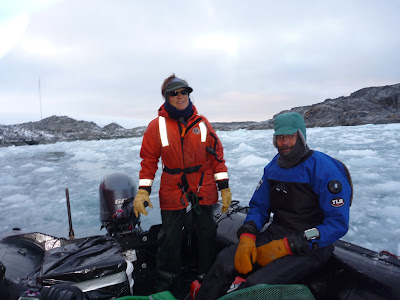One of the fun things I get to do here is dive tending. After some training, you get to sign up to go out and help the divers. They dive a *lot*, so there are plenty of chances to go. And because we're here to support science, it's no problem to break away from your day job to help out.
 |
| Maggie and Chuck Amsler |
What dive tending entails is helping the divers get the boat ready, load the diving gear, load everybody's emergency dry bags, sample bags, etc. After that you head out to the dive site. The dive sites are all in the GPS as way points, and the divers have been to all of them many times over the years, so we drove the boat straight to them.
 |
| Sabrina Heiser |
They sample the same sites year after year to get a time series of what's happening at them. Under water they have markers set along their transects as well as at the different depths that they sample at (they tend to dive island walls). The Amsler Lab is studying Antarctic macroalgae and we had a great lecture on their work at one of the Tuesday night science lectures we have every week.
 |
| CJ Brothers and Andrew Shilling |
Once you get to the dive site, you help the divers don their gear and get ready for the dive. On this trip we had one tender for each diver. Basically you just do whatever they ask. Hand them things, help with clips and buckles, defog their masks, and most important, help them glove up. They wear inner glove liners with those chemical hand warmer packs and then a dry glove over that. The dry gloves have to be pulled up over a plastic gasket on their dry suits and then you have to get this big rubber band over the outside to be sure it doesn't leak. This is the thing they stress the most-no leaky gloves. If they leak, it's all over for their hands. As it is, they get pretty cold, pretty fast, in spite of the inner gloves and hand warmers.
 |
| Sabrina with ammunition to blackmail her PhD advisor-sleeping on the job! |
After everybody is ready, they get into the water and one of the tenders keeps an eye on them, including pointing at them, while the boat driver backs away from them. After that they descend and do their dive. While they're down the tenders keep an eye on their bubbles and follow them as they dive their transect. We also keep an eye out for leopard seals, and if we see one, signal down to the divers to abort the dive and get back up immediately We also chat and eat snacks ;-)...
 |
| Maggie helping Andrew get ready |
I can't even begin to tell you how hard core these folks are. It is cold down there! Not only that, but they'll do 2-3 dives a day, sometimes more, and anywhere from a 1/2 hour to close to an hour per dive.
 |
| Almost ready |
When they come up, we help them with their tanks, weight belts, fins, and sample bags, as well as anything else they ask for.
 |
| Andrew ready to dive |
I thought that everybody would be pretty quiet when they got back up because they would be so cold, but no. They were chattering about all the great things they saw, the size and colors of the seaweeds they collected, changes from the last time they were there, etc. Respect!
 |
| Chuck and Sabrina in the water |
So this was my first time dive tending, I hope I get more chances to do it before all the science folks head home for the winter. Here are a few more pictures from this really fun day...
 |
| Sabrina and Andrew starting to descend |
 |
| Me and the Amsler Lab crew after the dive, minus Michelle Curtis |
 |
| Another beautiful day in Antarctica |
 |
| Photo bombed! |
P.s. One thing I wanted to mention. Those big orange jackets we're wearing are called Mustang float coats. We have to wear them when we're working on the pier tying up the ship, as well as when we're out on the boats. They're like a life preserver coat and are designed to keep you floating as well as keeping your head above water. They're pretty bulky, but also pretty warm which is a big help.













